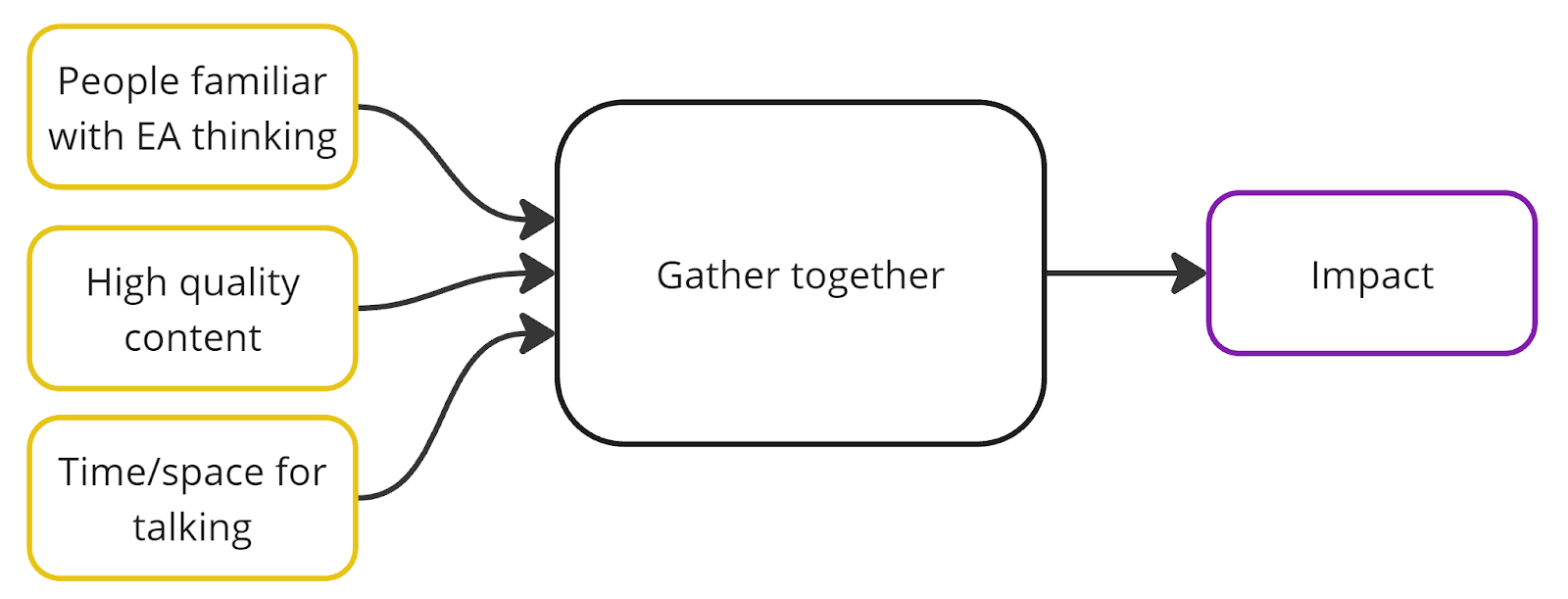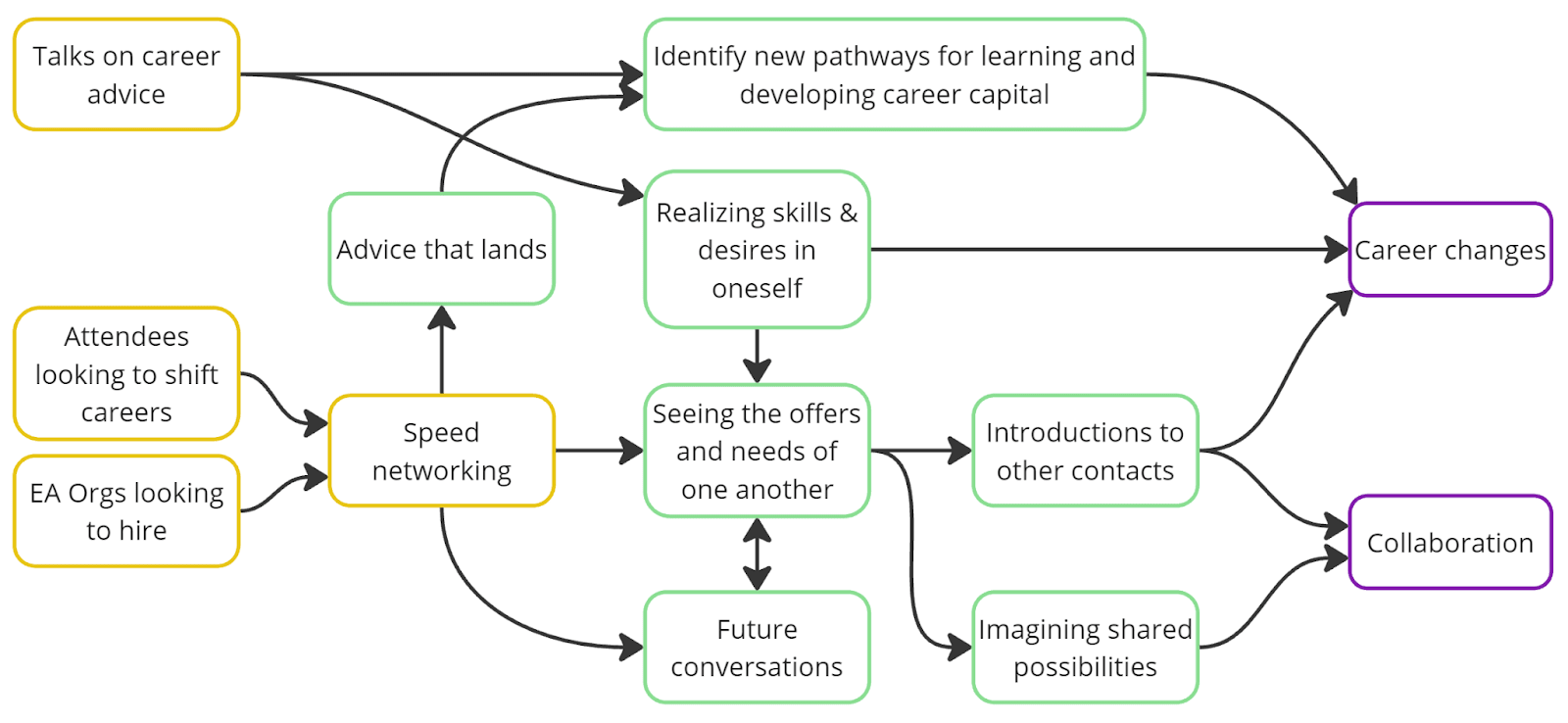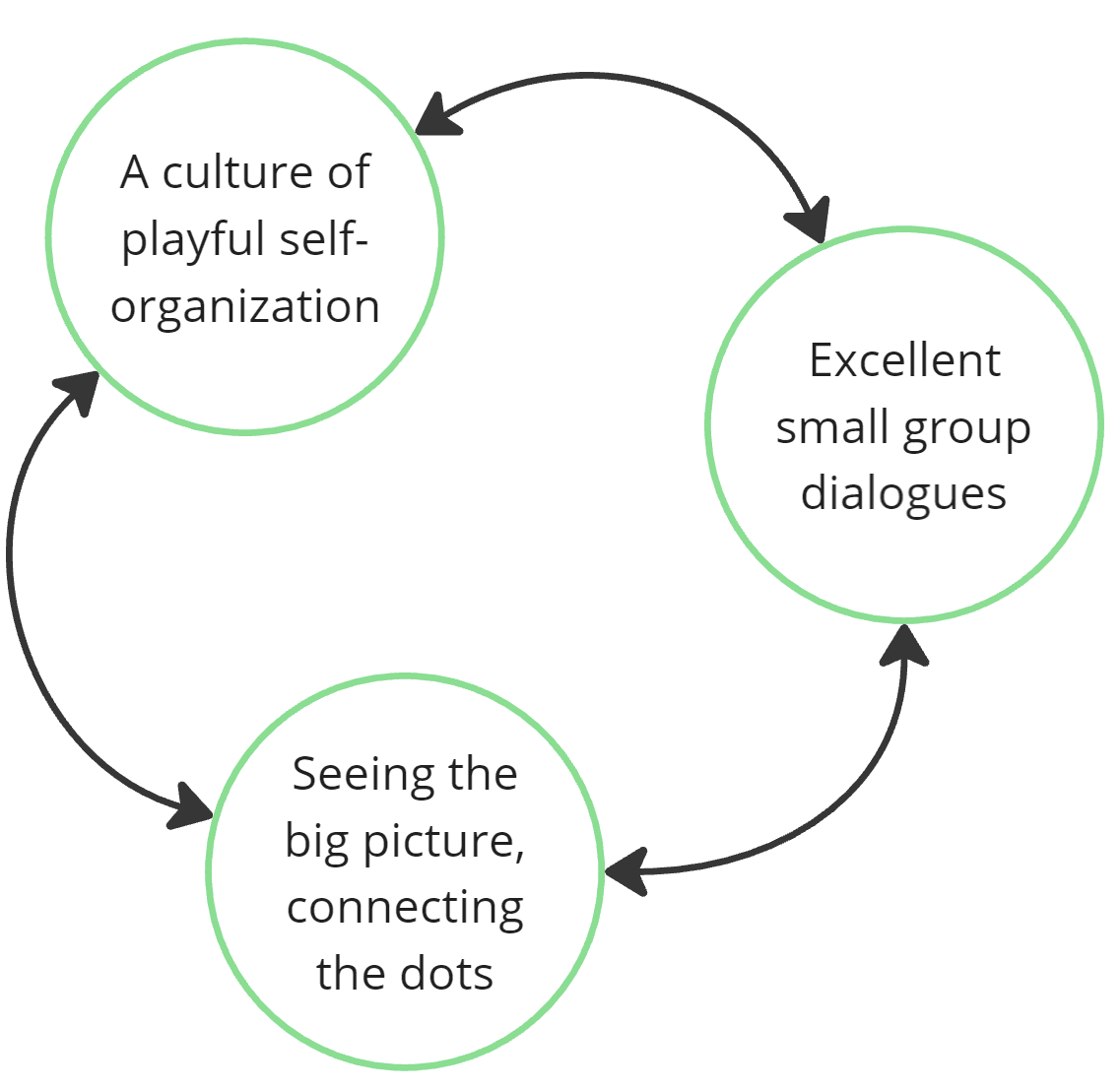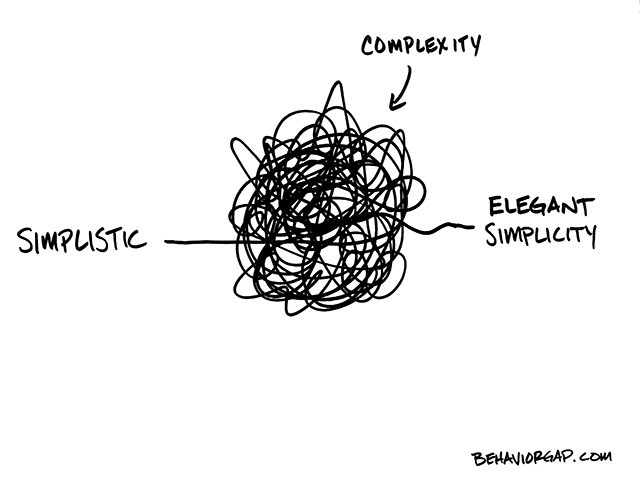A few months ago, I learned that some of my local EA friends were planning to host Canada’s first ever EAGx in my hometown of Toronto. I’ve been a part of the local ‘EATO’ chapter since 2018 when I first encountered EA, and have witnessed the community cycle through periods of excitement and dormancy. I was curious about how the organizers were thinking about this EAGx and how it may contribute to larger EA Canada strategies.
I’ve spent the last several years helping leaders to work with a ‘complexity lens’, to better understand how systems work by studying their interconnections and emergent properties. An EAGx is an example of a system, with its own emergent behaviours. In this post, I will bring this lens to the example of EAGxToronto, though I hope it will be useful for organizers and participants more broadly too!
In this post, I interviewed Liav, the Executive Director of EA Canada, about how he is thinking of the conference and what is in the works. I then share some theory that I hold around what parts of this gathering might act as leverage points to helping EAGxToronto lead to a thriving Canadian EA scene and an amazing experience for participants.
About EAGxToronto (from the website)
EAGxToronto is Canada’s first-ever effective altruism conference. Taking place from Aug 16-18, the conference provides networking opportunities, workshops, presentations, small group gatherings, and more, to over 350 attendees dedicated to addressing some of the world’s greatest challenges.
The conference provides networking opportunities, workshops, presentations, small group gatherings, and more, to approximately 400 attendees dedicated to addressing some of the world’s greatest challenges.
Complexifying our understanding
“For the simplicity on this side of complexity, I wouldn't give you a fig. But for the simplicity on the other side of complexity, for that I would give you anything I have.”
― Oliver Wendell Holmes
Naryan: How do we start to peel apart the way that we imagine EAGxs are actually, from a gears-level model, changing community to make the world a better place?
Liav: I think the general theory of change for these kinds of events is that it’s pretty high impact to get a bunch of people who have a minimum bar of familiarity with effective altruism in the same room together… You can give them high quality content, but also time to talk and network and meet each other, either to forge new connections or reinforce some existing connections. This can be very impactful.
Liav offered some of the kinds of outcomes that seem impactful for individuals:
- Career changes towards higher impact work
- Changes in donation behaviour towards greater effectiveness
- Deepening an understanding of EA ideas for individuals
I offered some impacts that I thought may be possible collectively:
- Identifying and exploring questions that are important to us
- Developing collaborations, partnerships, and organizations
- Fostering trust, care, and belonging within the EA Canada network and local communities
There’s probably much more that we could add, especially around the second-, third- and nth-order effects, but that’s for another post. I’m interested in describing some gears inside the ‘gather together’ black box (at least on some level—one person’s gear is another’s black box).
Wading into the complexity
First, let’s get into some of the details of what’s actually going to happen:
- The event lasts from Friday evening through Sunday afternoon, followed by a day-long unconference-style retreat on Monday.
- It takes place in a nice hotel downtown, with common areas and ~10 break-out rooms. Some of the programming will bring together everyone, but more often there will be 2-3 concurrent speakers/workshops, and a dedicated speed-meeting room. The other rooms will be open for participants to self-organize around.
- For communication, the event is using Swapcard so participants can message each other, book 1-on-1s and small group chats. There will also be a Slack channel for announcements and space for event-wide discussion.
- The speakers are mainly fellow Canadians, from all across the EA world and beyond - Global health, AI safety, effective giving, animal welfare, forecasting, effective careers, meta, biosecurity and more.
I’d guess that many participants will follow their curiosity: attending programming that seems interesting to them, booking chats with others who seem interesting too.
- Individuals will feel like they are learning and building relationships.
- There will be transitional moments when folks don’t know where to go, who to talk to or what to do next.
- There will be dinners with great chemistry—laughter, care and dialogue that goes deeper than expected.
- There will be volunteers behind the scenes practicing leadership, management and taking care of a million different details together.
Next, we’ll look at how they connect with one another. We might hypothesize a few different streams of causality here:
Over-analyzing at its best! Let’s do another one:
Each of these little diagrams pulls apart different parts of how we get from the inputs (orange) to the impacts (purple). Perhaps you have a different mental model of how things work, and would draw different diagrams—please do! More perspectives increases the complexity, which is what we’re up to as we attempt to describe what’s going on in the black box of ‘gather together’.
Why bother going through this complexity? Can’t we just trust the initial simple formula to work?
The simplicity on the other side
When we pull out the complexity of what’s going on, we can identify the things that really matter—the critical paths and the elements that matter to a variety of outcomes. This focus helps organizers direct their attention more effectively, and imagine creative new ways to nudge the system towards even better possibilities. For folks interested in a much better description of this process, check out the excellent Leverage Points: Places to Intervene in a System by Donella Meadows.
Wading through the complexity, as a practice, trains our intuition to more naturally sense these leverage points, and sense when a system may not perform as predicted. When I look at the upcoming EAGxToronto, I see a few leverage points that seem to connect many inputs with multiple outcomes:
A culture of playful self-organization
Early on, participants realize that there are fewer constraints than they normally operate with. They feel like a kindergartener with cups of paint, macaroni noodles, kraft glue, glitter and a big white wall that is here for them to paint. They feel brave enough to take chances—inviting someone they’ve just met to go for dinner with them, or saying ‘no’ to another invitation. With this vibe, people feel the energy and the safety to make things happen, and the EAGx feels alive. Yet it doesn’t feel like chaos. There is a rhythm to the activity, and it feels a bit more like a partner dance with 400 partners.
This may be enabled by:
- Explicit permission and encouragement by organizers
- Abundant ‘craft materials’ needed to self organize—the Slack, the empty rooms, projectors, whiteboards, stickies, markers
- Participants modeling these behaviours, visible and celebrated by the system
Excellent small group dialogues
When you find yourself with the right group of people, in the right environment, at the right time, magic happens. These are the conversations where deep insights happen, where emotional connection happens, where trust is built. I think there are some people who notice when these moments are possible, and they lean in, inviting others to do the same.
This may be enabled by:
- A spacious schedule—these conversations often happen over meals or late at night. Without being rushed.
- Small groups who like each other. It could be all new acquaintances, or old friends—I see it most often happen between 2-5 people.
- Deep listening, and perhaps experience with dialogue practices like authentic relating, Bohm dialogue, or collective presencing. More questions than answers. A conversation that matters to everyone.
- A warm ‘bubble’, where the outside distractions fade away. Maybe a cozy corner with plush chairs, or sitting by the lake.
Seeing the big picture, connecting the dots
At the end of the EAGx, many participants feel connected to the whole of what happened. They have a sense of how it all fit together—even the sessions they didn’t attend. From this place, we all have clarity on what might come next for EA in Canada, for our local groups, and for ourselves as individuals. The actions we are drawn to make sense across multiple scales, and seem to fit with one another. We agree on some new obvious collaborations, the whole can be greater than the sum of its parts.
This may be enabled by:
- Radically increasing feedback in the system. Organizers may offer recaps of what has happened, keeping track of themes that are emerging and communicating their sense back into the group. Survey walls with bingo stampers, sticky walls for reflection, or summary emails/posts can help.
- Participants who ask each other reflective questions like “What has stood out for you today?”, or “What do you sense is going on here?”. Once or twice might be interesting, but getting 5+ data points can create a more ‘3D’ sense of what’s going on over time. Facilitated spaces for this process could really accelerate this.
These three leverage points are also mutually supportive, each enabling the others:
I suspect that the conditions are here for each of these dynamics to come alive at EAGxToronto. I wonder how I, as a participant and a speaker, may help care for them? What indicators might I pay attention to during the conference, and how might I support others in caring for these?
My workshop will be on creating an EA Canada network map, quite literally visualizing the big picture, revealing patterns to enable greater coordination. I’m also a local—living just a 10-min bike ride from the venue. Perhaps I could also help make it easy for out-of-town participants to find dinner places and evening options that foster fun and connection?
Concluding
What I’ve shared here is an approach for thinking about complex systems: from a simplistic, wavy hands theory of change, to a messy overthinking of all the little gears and their connections, to a new simplicity that comes out of the messiness.
I love Tom McCallum’s image of this:
I hope that more of us EA organizers have fun getting messy with each other, building new understanding together, and trying new things. It’s worth it to spend the time in the details of our mental models in all their differences.
The leverage points I describe here didn’t come from a collaborative process with the EAGxToronto organizers, they came from my own personal experience organizing events. I’m sharing this piece with the organizers (and this forum), as part of an organic process of learning, where others may take this piece, remix it, and feed it into future events.
I’m so excited for EAGxToronto, and look forward to connecting with others from across Canada and beyond!
Applications close July 31, so apply ASAP✌️
Apply now







Thanks for writing this! I'm excited to see organisers and advisors really dive into theories of change for EAGx.
That said, I think the models here might benefit from looking at the existing data. Reading this post, you might think will be the first EA Global or EAGx event to take place—but there have been many, and we have lots of data on what people find useful.
The most useful post is probably this one.
I also gathered data about what part of the event was most valuable from 2023 events (from follow-up surveys, so asking people what was valuable several months after the event). Sharing below.
Key points:
a) Fostering a culture of playful self-organization
b) Facilitating excellent small group dialogues
c) Enabling participants to see the big picture and connect the dots
This comment was auto-generated by the EA Forum Team. Feel free to point out issues with this summary by replying to the comment, and contact us if you have feedback.